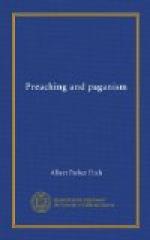Such naturalism is sometimes tolerated by those who aspire to urbane and liberal judgments because they think it can be defended on humanistic grounds. But, as a matter of fact, it is as offensive to the thoroughgoing humanist as it is to the sincere religionist. They have a common quarrel with it. Take, for example, the notorious naturalistic doctrine of art for art’s sake, the defiant divorcing of ethical and aesthetic values. Civilization no less than religion must fight this. For it is as false in experience and as unclear in thinking as could well be imagined. Its defense, so far as it has any, is based upon the confusion in the pagan mind of morality with moralizing, a confusion that no good humanist would ever permit himself. Of course, the end of art is neither preaching nor teaching but delighting. For that very reason, however, art, too, must conform—hateful word!—conform to fixed standards. For the sense of proportion, the instinct for elimination, is integral to art and this, as Professor Babbitt points out, is attained only with the aid of the ethical imagination.[18] Because without the ethical restraint, the creative spirit roams among unbridled emotions; art becomes impressionism. What it then produces may indeed be picturesque, melodramatic, sensual, but it will not be beautiful because there will be no imaginative wholeness in it. In other words, the artist who divorces aesthetics from ethics does gain creative license, but he gains it at the expense of a balanced and harmonious expression. If you do not believe it, compare the Venus de Milo with the Venus de Medici or a Rubens fleshy, spilling-out-of-her-clothes Magdalen with a Donatello Madonna. When ethical restraint disappears, art tends to caricature, it becomes depersonalized. The Venus de Milo is a living being, a great personage; indeed, a genuine and gracious goddess. The Venus de Medici has scarcely any personality at all; she is chiefly objectified desire! The essence of art is not spontaneous expression nor naked passion; the essence of art is critical expression, restrained passion.
[Footnote 18: Rousseau and Romanticism, p. 206.]
Now, such extreme naturalism has been the continuing peril and the arch foe of every successive civilization. It is the “reversion to type” of the scientist, the “natural depravity” of the older theology, the scoffing devil, with his eternal no! in Goethe’s Faust. It tends to accept all powerful impulses as thereby justified, all vital and novel interests as ipso facto beautiful and good. Nothing desirable is ugly or evil. It pays no attention, except to ridicule them, to the problems that vex high and serious souls: What is right and wrong? What is ugly and beautiful? What is holy and what is profane? It either refuses to admit the existence of these questions or else asserts that, as insoluble, they are also negligible problems. To all such stupid moralizing it prefers the click of the castanets! The law, then, of this naturalism always and everywhere is the law of rebellion, of ruthless self-assertion, of whim and impulse, of cunning and of might.




